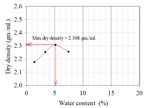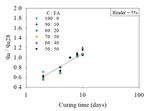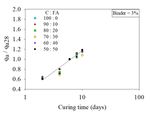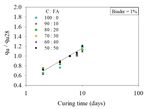STABILIZATION OF MARGINAL CRUSHED ROCK USING CEMENT AND FLY ASH AS A GREEN BASE COURSE MATERIAL
←
→
Page content transcription
If your browser does not render page correctly, please read the page content below
International Journal of GEOMATE, Jan., 2021, Vol.20, Issue 77, pp. 92-97
ISSN: 2186-2982 (P), 2186-2990 (O), Japan, DOI: https://doi.org/10.21660/2020.77.9430
Geotechnique, Construction Materials and Environment
STABILIZATION OF MARGINAL CRUSHED ROCK USING
CEMENT AND FLY ASH AS A GREEN BASE COURSE MATERIAL
Mathagul Metham1 Wutthiwat Mangkornngam1 Akepong Sedthamanop1 Wisitsak Tabyang2 Nart Sooksil3
Chayakrit Phetchuay4 and *Cherdsak Suksiripattanapong4
1
Bureau of Road Construction 2, Department of Highways, Thailand
2
Department of Civil Engineering, Faculty of Engineering, Rajamangala University of Technology Srivijaya,
Thailand
3
Department of Civil Engineering, Faculty of Engineering, Nakhon Phanom University, Thailand
4
Department of Civil Engineering, Faculty of Engineering and Architecture, Rajamangala University of
Technology Isan, Thailand
*Corresponding Author, Received: 25 Sep. 2020, Revised: 27 Oct. 2020, Accepted: 01 Dec. 2020
ABSTRACT: The use of marginal materials stabilized by cement for base course applications has grown
rapidly. Marginal materials consist of marginal crushed rock (MCR), marginal lateritic soil (MLS), and
reclaimed asphalt pavement (RAP). However, the use of cement will release high CO2 causing the greenhouse
effect. This research investigates the stabilization of marginal crushed rock using cement (C) and fly ash (FA)
as a green base course material. FA used as pozzolanic binders was obtained from the Mae Moh power plant
in Thailand. The physical and engineering properties of MCR stabilized by OPC-FA were evaluated according
to the specification of the Department of Highways in Thailand. The influencing factors studied included binder
content of 1%, 3%, and 5% by weight of the crushed rock material, C/FA ratios of 100/0, 90/10, 80/20, 70/30,
60/40, and 50/50, and curing time of 7. The optimum ingredient of MCR stabilized by B was found at a binder
content of 3% and C/FA ratios of 60/40. The strength development in MCR mixed with C and FA at all B
content and C/FA ratio can be normalized by 28-day compressive strength. The proposed equation is useful
for predicting the compressive strength of MCR mixed with C and FA. This research enables FA, which is a
residue material, to be used as a green base course material.
Keywords: Marginal crushed rock, Binder, Cement, Fly ash
1. INTRODUCTION which is a by-product of an electrical manufacturing
factory, Mae Moh, Thailand. FA is used as a
Transportation is significant for the pozzolanic material in Thailand (approximately 1.8
development of a country. Roadways and Highways million tonnes) [15]. However, the use of cement
are one major mode of transportation. According to and fly ash to stabilize marginal crushed rock
the Ministry of Transportation (2013), it was found (MCR) has not been investigated.
that the total of roads in Thailand were 115,707 km, The objective of this research is to investigate the
divided into Department of Highways, 68,253 km, possibility of using fly ash (FA) to improve the
and 47,454 km of the Department of Rural Roads. compressive strength of (MCR) as a green
Figure 1 shows the characteristic of road structure.
pavement material. The influential factors studied
Generally, roadways are constructed in four layers,
include MCR:binder ratios and cement:FA ratio.
which are composed of subgrade, subbase, base,
Unconfined compressive strength (UCS) of MCR
and surface layer. An available material at the road
construction site is used for road construction. mixed with cement and fly ash was investigated and
However, some of the available material does not compared the results with the standard of the
typically meet the standard requirement as base Department of Highways, Thailand. This research
materials. Marginal available materials can be enables FA, which is a residue material, to be used
effectively improved by chemical stabilizing agents as a green base course material. This research
with an additive, such as Portland Cement (OPC) enables FA, which is a residue material, to be used
[1-4], lime, and bitumen. However, the production as a green base course material. This stabilized
of 1 ton of OPC releases about 1 ton of carbon material would also enhance the novel eco-friendly
dioxide, resulting in a significant amount of contract, which was proposed by Metham and
greenhouse gas into the atmosphere [5-15]. Benjaoran (2018) [17].
Fly ash (FA) is an aluminosilicate-rich material,
92International Journal of GEOMATE, Jan., 2021, Vol.20, Issue 77, pp. 92-97
Fig.1 Characteristic of the road structure
2. MATERIALS AND METHODS OF
TESTING
2.1 Material
The marginal crushed rock (MCR) was collected
from Nakhon Ratchasima province, Thailand.
Figure 2 shows the grain size distribution of the
MCR. The MCR is classified as GC in accordance
with the Unified Soil Classification System. The
maximum dry unit weight and optimum water
content under modified Proctor energies of MCR
were 2.308 gm/m3 and 5.2%, respectively (Figure
3).
Portland Cement Type 1 (OPC) has a specific Fig.3 Compaction curves of MCR
gravity (Gs) = 3.10. The chemical composition of
OPC is shown in Table 1. It is found that the main Table 1 Chemical Properties of OPC and FA
chemical composition of OPC was calcium oxide
(CaO) content, which was 75.96%
Chemical OPC FA
Fly ash (FA) was collected from Mae Moh
composition (%) (%)
Power Plant, Lampang, Thailand. It is found that
FA has a brown color, and FA has a specific gravity SiO2 9.81 47.51
(Gs) = 2.31. The chemical composition of FA by Al2O3 4.64 13.14
using X-Ray Fluorescence Spectrometer (XRF)
Fe2O3 2.03 6.66
technique. According to ASTM C618 is shown in
Table 1. It can be soon that the amount of SiO2 + CaO 75.96 30.24
Al2O3 + Fe2O3 is 67.31% by weight. The calcium SO3 2.58 ND
oxide (CaO) content was 30.24%, and the loss of
K2O 1.62 1.63
ignition (LOI) was 0.42 by weight. This fly ash is
classified as a Class C fly ash. NO2 0.24 0.40
LOI 3.12 0.42
2.2 Methods of Testing
The composition of marginal crushed rock
(MCR) stabilized with cement (C) and fly ash (FA)
sample was MCR, C, FA, and water. Binder (B) is
a mix of C and FA. The B content was added by 0,
1, 3, and 5% by weight of MCR. The C/FA ratios
were 100/0, 90/10, 70/30, 60/40, and 50/50. The
mixing ratio used in the study is shown in Table 2.
The MCR and B were mixed until an observable
consistency was observed for 2 minutes. The
optimum water content was added, and 5 minutes
mixed. Under modified Proctor energies in
preventing liquid evaporation, compaction was
Fig.2 Grain size distribution of the MCR continued immediately thereafter. The mixture was
then compacted in a standard mold of 101.6 mm in
diameter and 116.4 mm in height. The Unconfined
Compressive strength (UCS) specimens were
93International Journal of GEOMATE, Jan., 2021, Vol.20, Issue 77, pp. 92-97
wrapped in clear vinyl and cured at room a binder (C and FA). For example, the 7-day
temperature for 7 days. compressive strength of MCR mixed with C and FA
samples with C/FA ratios of 60/40 were 12.7, 26.5,
and 28.5 ksc for B content of 1, 3, and 5%,
Table 2 Mixing ratio used in the study
respectively. The 7-day UCS of MCR mixed with C
and FA samples at B content of 5% and C/FA ratios
Mixed OPC FA of 100/0 give the highest UCS values, which is
proportion (%) (%) about 40 ksc. The 7-day UCS values of MCR mixed
M1 100 0 with C and FA at B content greater than 3% and
M2 90 10 C/FA ratios of 100/0, 90/10, 70/30, and 60/40 are
also met the minimum strength requirement for
M3 80 20 UCS of 24.61 ksc specified by the Department of
M4 70 30 Highways, Thailand [16]. The optimum ingredient
M5 60 40 (considering FA content) of MCR stabilized by B
was found at binder content of 3% and C/FA ratios
M6 50 50 of 60/40.
3. TEST RESULT
3.1 Compaction of MCR Mixed with C and FA
Table 3 shows the compaction results of MCR
mixed with C and FA at the B content of 1%, 3%,
and 5% and C/FA ratios of 100/0, 90/10, 70/30,
60/40, and 50/50. It can be seen that the maximum
dry unit weight of MCR mixed with C and FA
increases as B content increases because of the
higher specific gravity of C. The optimum water
content of MCR mixed with C and FA was about
4.1-4.85%. The maximum dry unit weight of MCR
mixed with C and FA was 2.288 gm/m3.
Table 3 The compaction results of MCR with C Fig.4 7-day compressive strength of MCR mixed
and FA with C and FA
Optimum water 3.3 Strength Development in MCR Mixed with
MDD C and FA
content
Mixed (gm/m3)
(%)
proportion Figures 5-7 show the compressive strength
1 3 5 1 3 5
(%) (%) (%) (%) (%) (%) development in MCR mixed with C and FA
samples at various at the B content of 1%, 3%, and
M1 2.236 2.261 2.257 4.85 4.40 4.33
5% and C/FA ratios of 100/0, 90/10, 70/30, 60/40,
M2 2.245 2.260 2.288 4.80 4.30 4.29 and 50/50. The compressive strength of MCR
M3 2.28 2.254 2.268 4.60 4.28 4.20 mixed with C and FA samples increased with
varying curing times for all ingredients. For
M4 2.268 2.255 2.260 4.55 4.20 4.20 example, the compressive strength of MCR mixed
M5 2.273 2.263 2.257 4.50 4.15 4.18 with C and FA samples with C/FA ratios of 80/20
M6 2.259 2.246 2.256 4.40 4.10 4.10 and B content of 5% were 32.1, 39.6, 57.6, 58.9, and
61.8 ksc for curing time of 7, 14, 28, 60, and 90
days, respectively. This is because the silica (Si) and
3.2 Compressive Strength of MCR Mixed with alumina (Al) from FA can react with calcium (CaO)
C and FA
from C stimulate, resulting in a pozzolanic reaction
(CSH) [17].
Figure 4 indicates the 7-day compressive
Figures 8-11 indicate the normalized strength
strength of MCR mixed with C and FA samples at
(quD/qu28) of MCR mixed with C and FA at C/FA
various at the B content of 1%, 3%, and 5% and
ratios of 100/0, 90/10, 70/30, 60/40, and 50/50, and
C/FA ratios of 100/0, 90/10, 70/30, 60/40, and
the B content of 1%, 3%, and 5%. It can be seen that
50/50. The 7-day compressive strength of MCR
the strength development in MCR mixed with C and
mixed with C and FA increases with the increase in
FA at all B content and C/FA ratio can be
94International Journal of GEOMATE, Jan., 2021, Vol.20, Issue 77, pp. 92-97 normalized by 28-day compressive strength. The correlation of normalized strength (quD/qu28) of MCR mixed with C and FA at different at C/FA ratios and B content was expressed by using a curve fitting as a logarithmic function as follow: quD/qu28 = 0.2882+0.193ln(D) for 7
International Journal of GEOMATE, Jan., 2021, Vol.20, Issue 77, pp. 92-97
5. ACKNOWLEDGMENTS
This research has been financially supported by
the Department of Highways, Thailand, and the
authors would like to acknowledge Rajamangala
University of Technology Isan, Nakhon Ratchasima
for the facilities support.
6. REFERENCES
[1] Chinkulkijniwat A., and Horpibulsuk S., Field
strength development of repaired pavement
using the recycling technique. Quarterly
Journal of Engineering Geology and
Fig.10 Normalized strength (quD/qu28) of MCR Hydrogeology, Vol.45, Issue 2, 2012, pp. 221-
mixed with C and FA at B content of 5% 229.
[2] Baghini M.S., Ismail A., Naseralavi S.S. and
Firoozi A.A., Performance evaluation of road
base stabilized with styrene–butadiene
copolymer latex and Portland cement.
International Journal of Pavement Research
and Technology, Vol.9, 2016, pp. 321–336.
[3] Jitsangiam P. and Nikraz H., Coarse bauxite
residue for roadway construction materials.
International Journal of Pavement Engineering,
14(3), 2013, pp. 265–273.
[4] Saghafi B., Al Nageim H. and Atherton W.,
Mechanical Behavior of a New Base Material
Containing High Volumes of Limestone Waste
Dust, PFA, and APC Residues. Journal of
Materials in Civil Engineering, Vol.25, Issue 4,
Fig.11 Normalized strength (quD/qu28) of MCR 2013, pp. 450-461.
mixed with C and FA at all B content and C/FA [5] Phummiphan I., Horpibulsuk S., Phoo-
ratio ngernkham T., Arulrajah A., and Shen S.L.,
Marginal Lateritic Soil Stabilized with
4. CONCLUSION Calcium Carbide Residue and Fly Ash
Geopolymers as a Sustainable Pavement Base
The marginal crushed rock mixed with cement Material. Journal of Materials in Civil
(OPC) and fly ash (FA) as a green base course Engineering, Vol.29, Issue 2, 2017.
material is presented in this study. [6] Phummiphan I., Horpibulsuk S., Rachan R.,
1. The maximum dry unit weight of MCR mixed Arulrajah A., Shen S.-L., and Chindaprasirt P.,
with C and FA increases as B content increases High calcium fly ash geopolymer stabilized
because of the higher specific gravity of C. lateritic soil and granulated blast furnace slag
blends as a pavement base material. Journal of
2. The optimum water content of MCR mixed
Hazardous Materials, 2018, pp. 257-267.
with C and FA was about 4.1-4.85%. The maximum
[7] Suksiripattanapong C. Horpibulsuk S.
dry unit weight of MCR mixed with C and FA was
Chanprasert P. Sukmak P. Arulrajah A.,
2.288 gm/m3. Compressive strength development in fly ash
3. The 7-day UCS of MCR mixed with C and geopolymer masonry units manufactured from
FA samples at B content of 5% and C/FA ratios of water treatment sludge. Construction and
100/0 give the highest UCS values, Which is about Building Materials. Vol.82, 2015, pp. 20–30.
40 ksc. [8] Suksiripattanapong C. Horpibulsuk S.
4. The strength development in MCR mixed Boongrasan S. Udomchai A. Chinkulkijniwat
with C and FA at all B content and C/FA ratio can A., and Arulrajah, A., Unit weight, strength and
be normalized by 28-day compressive strength. The microstructure of a water treatment sludge–fly
proposed equation is useful for predicting the ash lightweight cellular geopolymer.
compressive strength of MCR mixed with C and FA Construction and Building Materials, Vol. 94,
when 28-day compressive strength is known. 2015, pp. 807–816.
96International Journal of GEOMATE, Jan., 2021, Vol.20, Issue 77, pp. 92-97
[9] Phetchuay C., Horpibulsuk S., Arulrajah A., calcium carbide residue and fly ash. Journal of
Suksiripattanapong C., Udomchai A., Strength Materials in Civil Engineering, Vol. 24, Issue
development in soft marine clay stabilized by 2, 2012, pp. 184-193.
fly ash and calcium carbide residue based [14] Horpibulsuk S., Munsrakest V., Udomchai A,
geopolymer. Applied Clay Science, 2016, pp. Chinkulkijniwat A. and Arulrajah A., Strength
134-142. of sustainable non-bearing masonry unit
[10] Kampala A., and Horpibulsuk S., Engineering manufacturing from calcium carbide residue
properties of calcium carbide residue stabilized and fly ash. Construction and Building
silty clay. Journal of Materials in Civil Materials, Vol.71, 2014, pp. 210-215.
Engineering, Vol. 25, Issue 5, 2013, pp. 632- [15] Chindaprasirt P., Jaturapitakkul C., Chalee W.,
644. and Rattanasak U., Comparative study on the
[11] Kampala A., Horpibulsuk S., Chinkulkijniwat characteristics of fly ash and bottom ash
A., and Shen S.L., Engineering properties of geopolymers. Waste Management, Vol. 29,
recycled calcium carbide residue stabilized Issue 2, 2009, pp. 539-543.
clay as fill and pavement materials. [16] DOH., DH-S204/2000 standard of soil cement
Construction and Building Materials, Vol. 46, base. 2000.
2013, pp. 203–210. [17] Metham M., and Benjaoran V., Incentive
[12] Kampala A., Horpibulsuk S., Prongmanee N., contracts for road construction to reduce
and Chinkulkijniwat A., Influence of wet-dry greenhouse gas emissions. Engineering Journal,
cycles on compressive strength of calcium Vol.22, Issue 5, 2018, pp. 105-122.
carbide residue-fly ash stabilized clay. Journal
of Materials in Civil Engineering, Vol. 24,
Copyright © Int. J. of GEOMATE. All rights reserved,
Issue 1, 2014, pp. 633-643.
including the making of copies unless permission is
[13] Horpibulsuk S., Phetchuay C., and
obtained from the copyright proprietors.
Chinkulkijniwat A., Soil stabilization by
97You can also read



























































